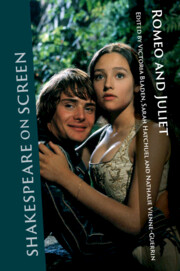Book contents
- Shakespeare on Screen: Romeo and Juliet
- Series page
- Shakespeare on Screen: Romeo and Juliet
- Copyright page
- Dedication
- Contents
- Figures
- Notes on Contributors
- Series Editors’ Preface
- Acknowledgements
- Chapter 1 Introduction – From Canon to Queer: Romeo and Juliet on Screen
- Part I Revisiting the Canon
- Part II Extending Genre
- Part III Serial and Queer Romeo and Juliets
- Chapter 11 Romeo and Juliet, Again and Again: Star-Crossed Lovers Adapted to Serial Television
- Chapter 12 Romeo and Juliet in the Japanese Anime Candy Candy: The Balcony Scene between Tradition and Subversion
- Chapter 13 The (Un)Queering of Romeo and Juliet on Film
- Chapter 14 Romeo and Juliet and Queer Temporality in Three Twenty-first-century Streaming Web-Series
- Chapter 15 Reviving Juliet and Surviving Romeo in Shakespeare Web-Series
- Chapter 16 Romeo and Juliet on Screen: Select Film-bibliography
- Index
- References
Chapter 16 - Romeo and Juliet on Screen: Select Film-bibliography
from Part III - Serial and Queer Romeo and Juliets
Published online by Cambridge University Press: 10 October 2023
- Shakespeare on Screen: Romeo and Juliet
- Series page
- Shakespeare on Screen: Romeo and Juliet
- Copyright page
- Dedication
- Contents
- Figures
- Notes on Contributors
- Series Editors’ Preface
- Acknowledgements
- Chapter 1 Introduction – From Canon to Queer: Romeo and Juliet on Screen
- Part I Revisiting the Canon
- Part II Extending Genre
- Part III Serial and Queer Romeo and Juliets
- Chapter 11 Romeo and Juliet, Again and Again: Star-Crossed Lovers Adapted to Serial Television
- Chapter 12 Romeo and Juliet in the Japanese Anime Candy Candy: The Balcony Scene between Tradition and Subversion
- Chapter 13 The (Un)Queering of Romeo and Juliet on Film
- Chapter 14 Romeo and Juliet and Queer Temporality in Three Twenty-first-century Streaming Web-Series
- Chapter 15 Reviving Juliet and Surviving Romeo in Shakespeare Web-Series
- Chapter 16 Romeo and Juliet on Screen: Select Film-bibliography
- Index
- References
Summary
The present chapter seeks to provide a selective reference guide to the screen adaptations of Romeo and Juliet up to 2021. This chapter is divided into three sections listing films, television adaptations as well as derivatives and citations. In each section, adaptations are classified in chronological order followed by an alphabetical list of relevant critical studies, and a system of cross-references has been designed for those entries making reference to two or more adaptations.
- Type
- Chapter
- Information
- Shakespeare on Screen: Romeo and Juliet , pp. 242 - 266Publisher: Cambridge University PressPrint publication year: 2023

